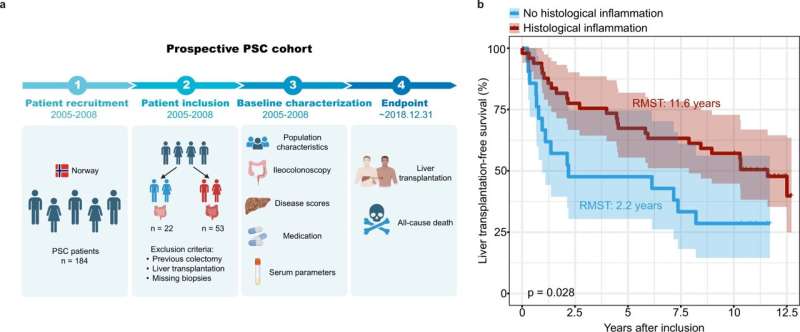
A mechanism underlying several liver diseases involves bile produced in the liver that cannot be secreted into the intestine as intended. This leads to a backlog of bile, which can damage the liver tissue.
The research groups of Prof. Trautwein (University Hospital RWTH Aachen) and Prof. Hengstler (Leibniz Research Center for Working Environment and Human Factors in Dortmund) have made a surprising discovery about the interaction of the liver and the intestine. The course of cholestatic liver disease may be milder when the liver disease is accompanied by an additional disease of the intestine. The team discovered that an inflamed intestine influences the liver to produce less bile acids.
Primary sclerosing cholangitis (PSC) is a cholestatic (cholestasis = “stagnation of bile”) liver disease characterized by chronic inflammation and progressive scarring of the bile ducts. Up to 80% of PSC patients simultaneously suffer from chronic inflammatory bowel disease, especially ulcerative colitis. This disease has been suggested to promote the development and progression of PSC. Since there are no effective drugs that improve the course of PSC, many patients develop cirrhosis of the liver—in which case liver transplantation remains the last therapeutic option.
Ulcerative colitis alleviates cholestatic liver disease by suppressing bile acid synthesis
The results of the study, now published in Nature Communications, show that a local inflammation of the intestine, which is triggered by the molecule dextran sulfate (DSS), induces major changes in the signaling pathways of the liver.
Thus, the teams from Dortmund and Aachen were able to detect an upregulation of the inflammatory pathways and, surprisingly, a suppression of bile acid synthesis and transport. The study identifies a molecular regulatory circuit by which inflammation of the intestine reduces the production if bile and thus suppresses the progression of the cholestatic liver disease.
The discovered molecular mechanism may be used in the future to slow down the production of bile acids when the liver cells are already overloaded with these substances. The contribution of the IfADo team consisted of a special functional imaging technique with which the concentrations of bile acids and other metabolites in the tissue can be visualized and analyzed.
Diseases of the liver also affect other organs
The liver is the largest organ of the human body and is responsible for more than 500 specific functions in the organism, for example the detoxification of toxic substances. Diseases of the liver also have a negative impact on cells and other organs, especially the brain, kidney and immune functions.
The liver also works closely with the intestines. It releases messenger substances into the intestine via the bile and conversely also receives signals from the intestine via the blood of the portal vein.
More information:
Wenfang Gui et al, Colitis ameliorates cholestatic liver disease via suppression of bile acid synthesis, Nature Communications (2023). DOI: 10.1038/s41467-023-38840-8
Journal information:
Nature Communications
Source: Read Full Article